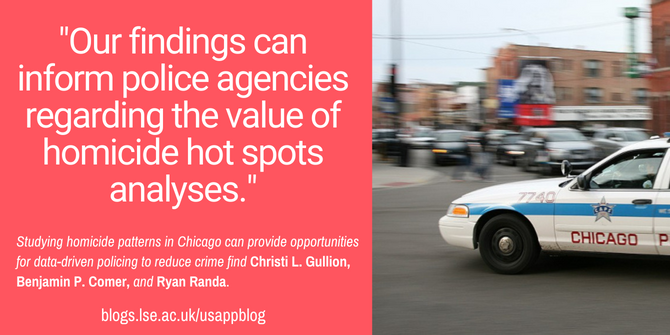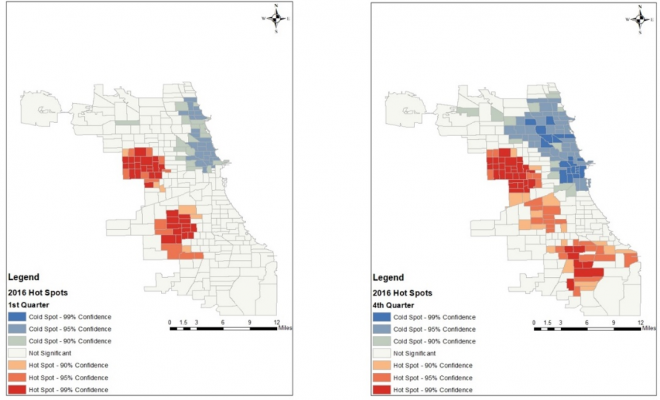

 Past research shows that crime – including homicides – often clusters in certain areas, but less is known about whether crime also clusters at certain times of year. In new research using policing data, Christi L. Gullion, Benjamin P. Comer, and Ryan Randa examine homicide hot spots in Chicago. They find that homicides in Chicago form a pattern in both when and where they occur, often concentrating on a small number of places in the spring and summer months. They write that these data-driven insights can help police agencies to identify and address crime hot spots.
Past research shows that crime – including homicides – often clusters in certain areas, but less is known about whether crime also clusters at certain times of year. In new research using policing data, Christi L. Gullion, Benjamin P. Comer, and Ryan Randa examine homicide hot spots in Chicago. They find that homicides in Chicago form a pattern in both when and where they occur, often concentrating on a small number of places in the spring and summer months. They write that these data-driven insights can help police agencies to identify and address crime hot spots.
Research consistently shows that crime levels tend to be relatively stable over long periods of time, although this depends on they type of crime being looked at and the area and lengths of time being examined. In addition, crime, including homicides, tends to cluster, forming hot spots within cities, neighborhoods, blocks, and streets. Identifying and understanding how homicide hot spots cluster over time provides police agencies the opportunity to appropriately allocate resources to their specific areas and implement focused crime reduction strategies.
Yet only a few studies have explored the spatial clustering of homicides over time. Moreover, the analysis of homicide hot spots using smaller amounts of time blocks (i.e., months) across large lengths of time (i.e., across several years) has remained relatively unaddressed. The need to do so is important because examining data only in large time blocks may mask changes in homicide clusters that would otherwise emerge. Additionally, due to the seriousness of violent crimes against persons, homicides receive the greatest allocation of time and investigative resources from police. This makes it important to examine homicide patterns through space and time to better inform the allocation of police resources.
What do we know about Chicago homicide hot spots?
Chicago homicide hot spots studies are largely consistent with homicide hot spots studies conducted in other US and international cities. First, Chicago homicide hot spots and cold spots are relatively stable in space and time, with hot spots concentrating in the west and south sides of the city. Second, Chicago hot spot studies have found evidence that homicide hot spots move to nearby areas, including where they had not previously occurred. Third, Chicago homicide studies have found a significant correlation between neighborhood and/or community-level factors and homicide hot spots and cold spots. Fourth, most Chicago hot spot studies have not tracked the location of homicides using small units of time. However, two Chicago-focused studies that used smaller units of analysis to examine homicide clusters found effects of hot spots changing location and that the predictive processes for stable homicides and time changing homicides were significantly more accurate than random predictions.
Examining Chicago homicide hot spots by police beats
To date, few studies have addressed the variability of homicide clusters over time using smaller units of time. Even fewer have used police beats as the spatial unit of analysis. With this in mind, to determine how, where (including in which police beats) and when homicides cluster we analyzed five years (2016-2020) of publicly available reported homicide data using police beats provided by Chicago Police Department’s (CPD’s) CLEAR (Citizen Law Enforcement Analysis and Reporting) system.
From 2016 and 2020, over 3,000 homicides were recorded across 277 police beats in Chicago. Homicide data were subdivided into three-month blocks within each year giving 20 quarters across five years. Next, Average Nearest Neighbor (ANN) and hot spot analyses were conducted in ArcMap to determine trends and patterns.
We found that a very small percentage of all police beats experienced three or more homicides within their boundaries for each quarter (e.g., for the third quarter of 2020, 11.9 percent of all police beats had at least three or more homicides). Thus, higher homicide counts may be clustering in select police beats.

Daniel Schwen, CC BY-SA 4.0, via Wikimedia Commons
In Chicago, homicides are clustered in location and time
Our results also showed that for every quarter, homicides were significantly spatially clustered across all 20 quarters examined. In addition, homicides across all 20 quarters follows a predictable rhythmic pattern of spatial densification and expansion across the four quarters in each year (see Figure 1). The largest average distance between homicides occurred in the first quarter whereas the smallest occurred in the third quarter of 2020.
Figure 1 – Homicide Cluster Fluctuations in Tenths of a Mile by Quarter 2016-2020

We also found statistically significant hot spot clusters and cold spot clusters for all quarters across all years (e.g., see Figure 2: the first and fourth quarters 2016). Specifically, one homicide hot spot was in a stable location in Northwest Chicago, while numerous hot spots merge, move, and dissolve in Southside Chicago. Data indicates that the proportion of police beats that form homicide hot spots see increases during spring and summer months (April–September) and then decrease during fall and winter months (October–March) for all 5 years. These homicides occur in a small proportion of police beats, resembling other studies that find most crime concentrates in a small percentage of places.
Figure 2 – Homicide Hot and Cool Spots by Quarter 2016

Data-driven policing and progressive police agencies
While the results of our study have substantial insights for Chicago regarding homicide hot spots, they also offer policy implications for police agencies in identifying and addressing crime hot spots. Data-driven policing is key for any progressive police agency that intends on developing and implementing focused intervention strategies that specifically target homicides in their communities, both in low and high-crime areas.
Agencies can utilize crime analysts or partner with academic or research institutions to examine hot spot spatial and temporal trends. Using spatial analysis of crime hot spots to inform the allocation of resources is a better course of action than traditional approaches, including routine patrol staffing all areas and reliance on overtime when homicides spike in certain areas. Hot spot policing research demonstrates that problem-oriented policing, foot patrol, and place-based policing strategies have a greater effect on crime compared to more traditional policing strategies. Furthermore, hot spots policing research finds certain strategies have positive crime reduction and prevention effects resulting a diffusion of benefits into adjacent areas around hot spots, not necessarily crime displacement.
Ultimately, our findings can inform police agencies regarding the value of homicide hot spots analyses. We encourage future scholars to continue examining spatial and temporal clustering of crime hot spots and their stability and fluctuation over time.
- This article is based on the paper, ‘Homicide Hot Spots in Chicago: Examining Spatiotemporal Patterns Longitudinally Across Police Beats’, in Crime & Delinquency.
- Please read our comments policy before commenting.
- Note: This article gives the views of the author, and not the position of USAPP – American Politics and Policy, nor the London School of Economics.
- Shortened URL for this post: https://bit.ly/3IMYG0v






